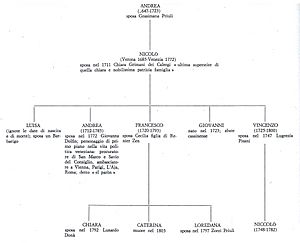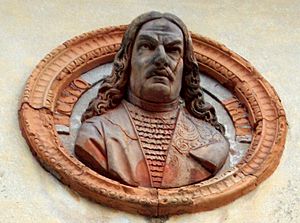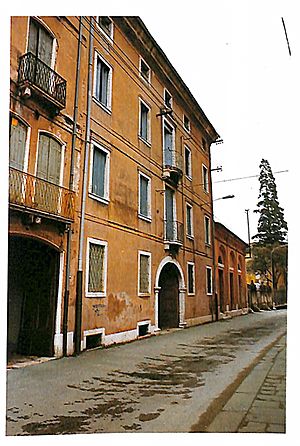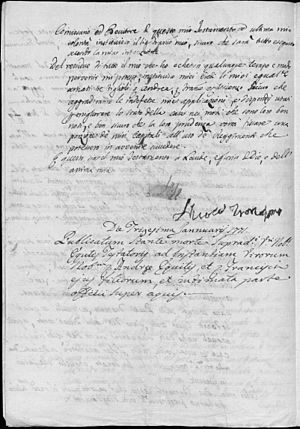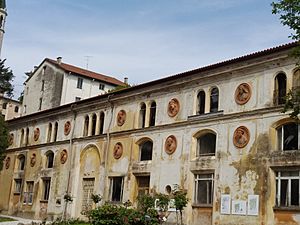Nicolò Tron (diplomat) facts for kids
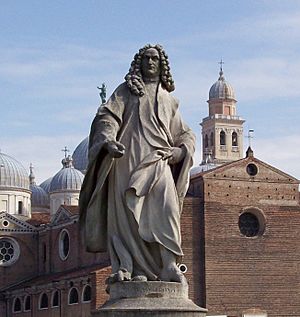
Nicolò Tron (born September 21, 1685 – died January 31, 1771) was an important Italian politician, businessman, and farmer from the Republic of Venice.
Nicolò was a Venetian noble who served as a young ambassador in England. When he returned home, he tried to bring new ideas and technologies he had seen abroad. He started a wool factory in Schio, improved his farms with modern methods, and used his political power to help Venetian businesses grow.
Contents
Life Story
Nicolò Tron was born in 1685 in Padua. He came from a noble Venetian family, related to an earlier Doge of Venice who lived two centuries before him. He studied at a special school for nobles in Parma. When he was young, he began his political career as a Savio agli Ordini. This was the first important role a young noble could have in the Senate.
In 1711, Nicolò married Chiara Grimani. People at the time said she was one of the most beautiful women. A year later, on October 3, 1712, their first son, Andrea Tron, was born. Andrea also had a very successful political career and became known as the "paròn del Senato" (meaning "Master of the Senate").
Ambassador in London
On December 10, 1712, Nicolò Tron was chosen to be the ambassador to Queen Anne of Great Britain. His job was to ask the British court for help in the wars Venice was fighting against the Ottoman Empire.
Tron arrived in London in June 1714. By then, Queen Anne had been replaced by King George I. Nicolò preferred spending time with scientists and mathematicians instead of just the royal court. He met famous people like Isaac Newton, who made him a Fellow of the Royal Society. He also met John Theophilus Desaguliers, a French mathematician and physicist. Desaguliers started the Grand Lodge, which is linked to modern Freemasonry. Tron also met businessmen like Benjamin Berck, a famous wool manufacturer, who showed him new English manufacturing techniques.
The Venetian government wasn't very happy with how their ambassador was spending his time. They sent him letters reminding him of his duties. They even sent a helper, Giacomo Querini, to support him. Tron accepted Querini's presence without any problems.
At the end of his time, King George made Tron a knight in his new Order of St. George. However, England did not give Venice the military help it wanted against the Ottomans. England had important trade deals with the Turks and didn't want to go to war with them. Tron probably didn't push hard enough for the military support. But, thanks to his friendship with the Spanish ambassador, Tron did get six ships for Venice.
Coming Home
Nicolò Tron returned to Venice in the summer of 1717. He brought with him technicians and machines to share the new ideas and technologies he had seen in England. His biggest project was creating a wool factory in Schio. He also worked on improving his farms in Anguillara and other places.
In England, he had seen the first hydraulic steam pumps. These machines were first made by Thomas Savery in 1698 and later improved by Thomas Newcomen and Denis Papin. They had been available for sale since 1712. The technology was still new and not very efficient. But Tron understood how important they could be. He brought English technicians to Italy to build these machines on his farm in Anguillara Veneta. He wanted to use them to drain swampy areas. This project didn't work as well as he hoped, partly because one English technician died and another left.
However, this didn't stop Tron from building similar machines in the hills around Schio, in an area called Tretto. He used them to pump water out of kaolin and carbon mines. This technology was probably too new to be profitable at the time. So, it remained an experiment in just these two locations. But it was the first time these machines were used outside of England.
Around these mines, a Scottish mathematician named James Stirling also worked. He was known as "the Venetian." Stirling had to leave England because of political problems related to Jacobitism. Tron helped him find safety in Italy. Stirling even dedicated his book, Lineae tertii ordinis Newtonianæ, to Tron. Both Stirling and Tron hoped Stirling could get a math teaching job at the University of Padua. This didn't happen, possibly because people who followed Gottfried Wilhelm Leibniz's ideas were preferred over those who followed Newton's. We only know that Stirling visited the university once on March 25, 1721.
Wool Mills in Schio and Follina
Nicolò Tron's most important work was starting the Tron wool mill in Schio. When he first returned home, he tried to bring new technologies to Venice. But the powerful wool guilds there strongly opposed him. So, he decided to build his factory elsewhere. He chose Schio because the town had recently (1701) been allowed to make high cloths. These were the finest fabrics meant for export. In 1718, Tron found a good environment in Schio. The guilds were not as strong as in Venice, and there were many skilled workers who didn't cost much.
He rented a workshop and some land. He brought 9 English technicians and their families to Schio. He started making fine and very fine fabrics using new ways of weaving, dyeing, and preparing raw materials. In a very open way, he initially left his factory doors open. This allowed other companies in the area to see and learn about the new technologies. In just a few years, his company had 26 looms, produced 300 pieces of fabric a year, and employed 600 people.
To help the Schio wool mill, Tron also bought a share in the historic wool mill of Follina in 1749. He partnered with the German Georg Ernst Stahl, who became its director. The Follina mill had been very successful in the late 1600s but was struggling by the mid-1700s. Just like in Schio, Tron introduced new methods, like the londrine seconde. He brought in foreign technicians and used new technologies. Within a few years, the Follina factory employed a thousand people, making it one of the largest factories in Italy. From 1766, a Frenchman named Jean Pierre Douarche worked at both the Schio and Follina mills. He introduced the flying shuttle, invented by John Kay. This invention cut the amount of labor needed for weaving in half.
This huge growth didn't last forever. In later years, production decreased. From 1726, Tron gave others the job of managing the company, and even shared ownership. The reasons for this decline have been studied a lot:
- It was hard to sell the new products. Their costs were not as low as some fabrics from other countries, like those from the Eastern world.
- Tron did not manage the company directly. He left its management to other people.
- There were problems managing the workers. Many were part-time and also worked on farms. This made quality control harder.
- There was strong competition. Not only from foreign trade, but also from smaller factories nearby. These smaller factories quickly learned the new technologies and hired the best workers.
Political Work
Nicolò Tron was mainly known to people of his time as a politician. He was very involved in the economy and finances of the Republic of Venice. In 1726, he was chosen as an adviser for trade. In 1737, he became the Captain of Padua. From 1739 to 1741, he was the General Superintendent in the region of Friuli. In his political roles, he mostly tried to help Venetian businesses compete against goods from other countries.
He passed away in Venice in 1771.
What He Left Behind
Among Nicolò Tron's many activities, his textile factory in Schio was the most important. After Tron died, his factory was shared with Francesco Rubini. Rubini was a former worker who became a business owner. Five years later, he bought the part inherited by Francesco Tron (Nicolò's son). By the end of the century, Rubini led the factory to a new period of success. After that, and after other changes in ownership, the business was eventually owned by Alessandro Rossi. Rossi founded Lanerossi, which became one of the biggest textile industries in the world in the second half of the 18th century.
Honors and Memorials
- In Padua, in the large square called Prato della Valle, a statue was made to honor him. The statue shows a cornucopia at his feet. This symbol often means plenty or abundance, which can relate to his success in trade.
- In Schio, a bust (a sculpture of his head and shoulders) was dedicated to him. It is placed on the front of palazzo Toaldi Capra, which was called "Palazzo Tron" until 1980.
- Also in Schio, another bust made of earthenware decorates the front of the Jacquard theater. This theater is near where Tron's factory used to be many years ago.
- In Schio, a high school (called a Liceo scientifico) and a road are also named after him.
Different Ways His Name Is Written
- The name Nicolò Tron is written this way in documents from his time and in most modern historical research.
- On the monument in Prato della Valle, Padua, and on the bust in Schio, his name is written in Latin: Nicolao Trono.
- In some modern studies, the name is Italianized by doubling the "c" letter: Niccolò Tron.
- In the Royal Society archive, his name is listed as Troni Nicolo.
See also
- Tron family
- Schio
- James Stirling (mathematician)


